The actual behavior across different devices is inconsistent. The resize and orientationChange events can fire in a different sequence with varying frequency. Also, some values (e.g. screen.width and window.orientation) don't always change when you expect. Avoid screen.width -- it doesn't change when rotating in iOS.
The reliable approach is to listen to both resize and orientationChange events (with some polling as a safety catch), and you'll eventually get a valid value for the orientation. In my testing, Android devices occasionally fail to fire events when rotating a full 180 degrees, so I've also included a setInterval to poll the orientation.
var previousOrientation = window.orientation;
var checkOrientation = function(){
if(window.orientation !== previousOrientation){
previousOrientation = window.orientation;
// orientation changed, do your magic here
}
};
window.addEventListener("resize", checkOrientation, false);
window.addEventListener("orientationchange", checkOrientation, false);
// (optional) Android doesn't always fire orientationChange on 180 degree turns
setInterval(checkOrientation, 2000);
Here are the results from the four devices that I've tested (sorry for the ASCII table, but it seemed like the easiest way to present the results). Aside from the consistency between the iOS devices, there is a lot of variety across devices. NOTE: The events are listed in the order that they fired.
|==============================================================================|
| Device | Events Fired | orientation | innerWidth | screen.width |
|==============================================================================|
| iPad 2 | resize | 0 | 1024 | 768 |
| (to landscape) | orientationchange | 90 | 1024 | 768 |
|----------------+-------------------+-------------+------------+--------------|
| iPad 2 | resize | 90 | 768 | 768 |
| (to portrait) | orientationchange | 0 | 768 | 768 |
|----------------+-------------------+-------------+------------+--------------|
| iPhone 4 | resize | 0 | 480 | 320 |
| (to landscape) | orientationchange | 90 | 480 | 320 |
|----------------+-------------------+-------------+------------+--------------|
| iPhone 4 | resize | 90 | 320 | 320 |
| (to portrait) | orientationchange | 0 | 320 | 320 |
|----------------+-------------------+-------------+------------+--------------|
| Droid phone | orientationchange | 90 | 320 | 320 |
| (to landscape) | resize | 90 | 569 | 569 |
|----------------+-------------------+-------------+------------+--------------|
| Droid phone | orientationchange | 0 | 569 | 569 |
| (to portrait) | resize | 0 | 320 | 320 |
|----------------+-------------------+-------------+------------+--------------|
| Samsung Galaxy | orientationchange | 0 | 400 | 400 |
| Tablet | orientationchange | 90 | 400 | 400 |
| (to landscape) | orientationchange | 90 | 400 | 400 |
| | resize | 90 | 683 | 683 |
| | orientationchange | 90 | 683 | 683 |
|----------------+-------------------+-------------+------------+--------------|
| Samsung Galaxy | orientationchange | 90 | 683 | 683 |
| Tablet | orientationchange | 0 | 683 | 683 |
| (to portrait) | orientationchange | 0 | 683 | 683 |
| | resize | 0 | 400 | 400 |
| | orientationchange | 0 | 400 | 400 |
|----------------+-------------------+-------------+------------+--------------|
